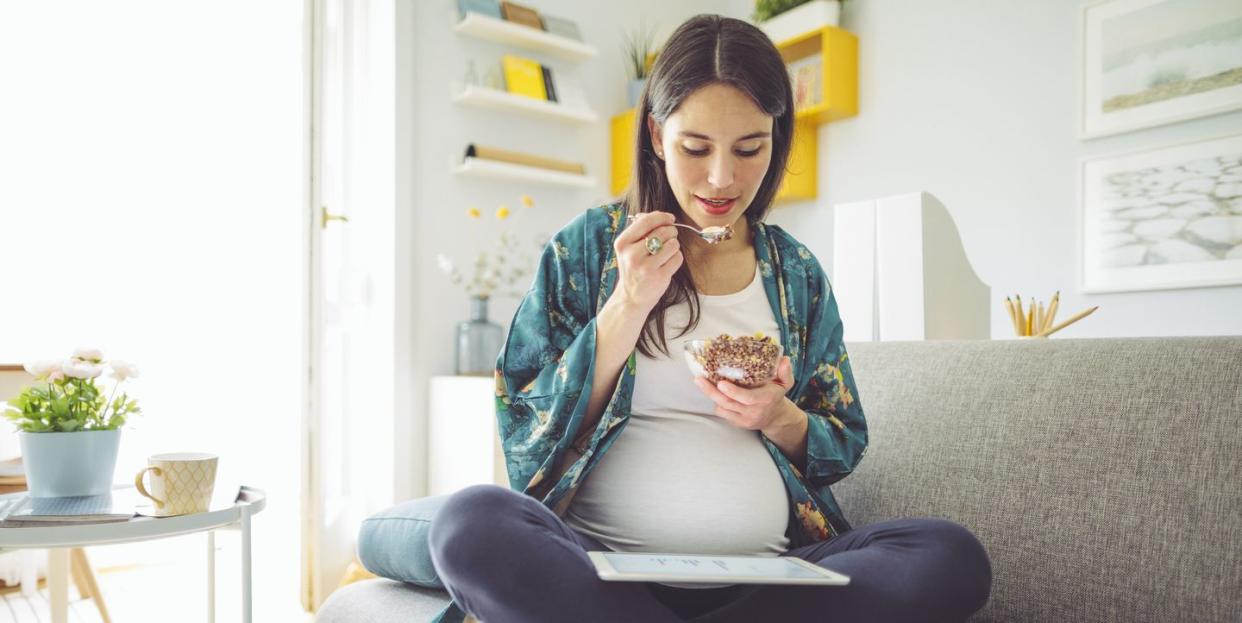Tips for healthy pregnancy weight gain and exercise

If you’re pregnant, the last thing you want to think about is your weight. But it is important to keep an eye on your pregnancy weight gain as putting on too much or too little can increase the risk of complications for both you and your unborn baby.
Almost half of all pregnant women attending their first maternity appointment are overweight or obese, which can increase your risk of gestational diabetes and put you at a higher risk of miscarriage or the possibility of requiring a Caesarean section.
So how much weight should your be putting on during pregnancy? Should you really be ‘eating for two’? Fitness expert Lucy Howlett answers the important questions, so you can focus on the important things: being healthy and growing a human.
How much weight should you gain in pregnancy?
The average weight gain during pregnancy, inclusive of the baby, the fluid surrounding it and the extra weight due to the enlargement of the womb, is between one and a half and two stones. Much more than this and you are gaining extra fat, which is not necessary and could prove difficult to shift afterwards.
If you’re pregnant or planning a pregnancy you don’t need to go on a special diet, but it is important to include a variety of different healthy foods in your diet to get the right balance of nutrients, so your baby can develop.
You should be able to get all the vitamins and minerals you need from the foods you eat, but when you're pregnant it is also worth taking a folic acid supplement for the development of a healthy foetus.
Can you still exercise when you’re pregnant?
Women have traditionally been advised to put their feet up the minute they become pregnant, but keeping active when you’re expecting is actually more important than ever.
‘You can still exercise, if you've been given the all-clear from your doctor or midwife,’ says Howlett. ‘In your first trimester, low-impact circuit training – lunges, squats and bent-over rows – is a great way to strengthen your body in preparation for the changes to come,’ says Howlett. ‘It boosts your circulation and lung function, too, which will benefit both you and your baby. Just take it easier than you normally would and keep lowering the intensity as your pregnancy progresses.’
There are some high-intensity moves you should save until after the baby arrives though. ‘Avoid weight-bearing exercises where you bend at the waist, such as deadlifts – they put too much pressure on your lower back and can make you feel dizzy. Also skip anything that involves lying flat on your back as it can put pressure on the main blood vessel that brings blood to your heart.’

Yoga during pregnancy
Yoga is a stress-free, low-impact workout that is perfect for mums-to-be. ‘It helps build strength while toning your muscles and improving posture,’ says Howlett.
‘Plank pose is great for your arms and core, especially as your bump grows. Meanwhile, chest opening poses will help to strengthen and reduce pressure on your back.’
If you’re new to yoga, look out for prenatal specialist yoga classes in your area.
Running during pregnancy
Running is a great exercise for expectant mums, provided you already have some experience in this area. ‘If you’re already a runner pre-pregnancy, you can continue as long as you take it easy – although it’s worth checking with your midwife first, and you shouldn’t continue running beyond 20 weeks pregnant,’ advises Howlett.
‘While 5-10km is a safe distance, don’t try to break any records right now – if your core temperature gets too high, it can affect your baby, so save the half-marathon for after the birth.’
If you’ve been thinking about taking up running and recently discovered you’re pregnant, now is not the best time to start. ‘You won’t know what’s comfortable for your body and it can be hard on your knees, which already have extra weight to carry,’ says Howlett. ‘After the birth, wait at least 12 weeks to start running again and make sure you do pelvic floor exercises first.’
Cycling during pregnancy
Cycling is an excellent low-impact exercise option. ‘As with running, if you’re already a cyclist, you needn’t stop, especially in the early days of your pregnancy,' says Howlett. ‘You might even find it less tiring than walking, and the fresh air could help ease morning sickness or back pain.’
‘Your bump will affect your centre of gravity, though, so alter the height of your saddle to accommodate this,’ she adds. ‘And cycle slowly – the same rules apply regarding overheating.’

Exercising in the last trimester
When you hit the home stretch, your bump might become cumbersome and make you feel less like exercising, but unless specified by your doctor, there’s no reason why you shouldn’t still keep active. ‘Just take it easy, with longer breaks in between workouts,’ advises Howlett. ‘Swimming is a great option and it'll make you feel weightless.’
‘Just remember that your body starts to release the hormone relaxin, to promote joint and ligament flexibility in your hips and other areas, and make room for your baby,’ she adds.
‘This can make you more flexible, so take care not to overextend. And avoid workouts with jerky or bouncy movements. Not only will it be uncomfortable, but your shifted centre of gravity means you’re more susceptible to falling over!’
Last updated: 06-10-2020
You Might Also Like

